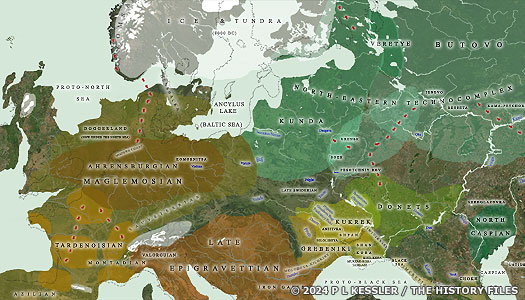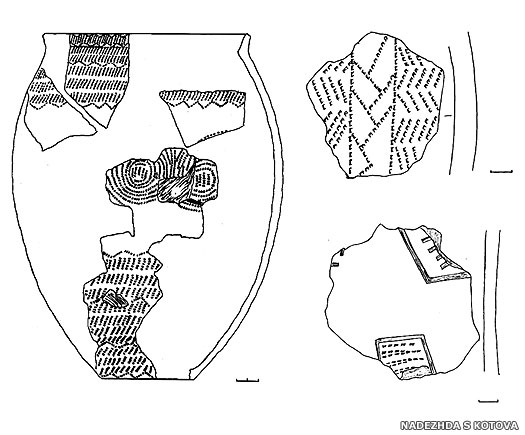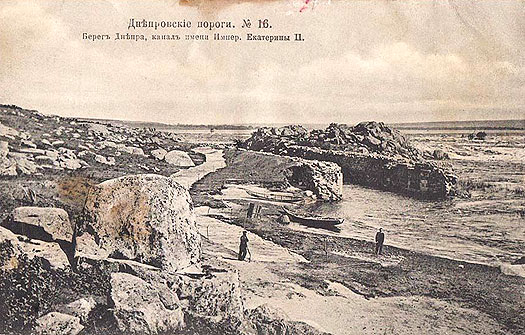Dnieper-Donets I Culture (Neolithic Foragers) (Eastern Europe) c.6500 - 5000 BC The crossover between the Upper Palaeolithic and Mesolithic in Europe (and more specifically Northern Europe) took place about a millennium after the wide-ranging Magdalenian had faded. The later Swiderian culture which was so important in this specific instance was centred around modern Poland, with extensions both eastwards and southwards. On the Eastern European fringe of the Swiderian, and of the Epigravettian which was initially so strong in Southern Europe, there appeared a number of more or less contemporaneous Epi-Palaeolithic (Late Old Stone Age) and early Mesolithic cultures. This mainly took place in the steppe zone across the northern Black Sea region, but activity was also taking place between the Vistula and the Ural mountains. In time, creeping pastoralism would initiate a Neolithic introduction into this region. The Swiderian-derived Dnieper-Donets I culture succeeded the Kunda and Butovo cultures. Abbreviated to 'DDI' for the sake of brevity, it is also often referred to in Eastern European papers as Dnieper-Donetsk. It heralded the emergence of Neolithic foragers and the end of the regional Mesolithic. Occupying a huge sweep of Ukrainian territory, the DDI took in the forests of Belarus in the north and the dry steppe of Crimea to the south. It encompassed the steppe region around the Dnieper right over to the Sea of Azov. It appeared at the same approximate time as its neighbour to the west, the Bug-Dniester culture, while Dnieper-Donets II (DDII) was its direct successor. It has also been used as an umbrella culture for two other groups or cultures which emerged at uncertain dates, possibly around the same time as DDI or perhaps only alongside DDII (the date depends upon the archaeologist being questioned). Those cultures are the Azov-Dnieper and Mariupol. This 'umbrella' practice seems largely limited to older works however. In the twenty-first century all three cultures can be referred to on an individual basis. The shared heritage between the Neolithic people of the DDI and Bug-Dniester led back to their shared Mesolithic heritage. They would have spoken a similar - if descended - language which was almost certainly different from that of the advanced Neolithic Farmer cultures which were emerging to their collective immediate west. In fact, their language was quite likely a very close relation to proto-Indo-European. Dating for and the general location of the nearby Dnieper-Desna culture along the Dnieper and its Desna tributary means it was most likely on the migratory trail for groups from the Butovo and Kunda cultures to its north. Around 6500-6000 BC there seems to have been a movement of Butovo and Kunda people towards the plains on the eastern side of the River Dnieper. This is where the DDI soon emerged, making it likely that the Dnieper-Desna was also involved in the Indo-European-building process. The traditional Neolithic/Chalcolithic (or Copper Age) chronology of the Dnieper valley is based on several archaeological sites near the Dnieper rapids (between Dnipro and Zaporizhzhia). The most important of those are Igren 8, Pokhili, and Vovchock, at which a repeated stratigraphic sequence has been found. The earliest levels display the typical early Neolithic pots and microlithic flint tools which are associated with the hunting of wild animals (principally around 6200-5700 BC). The next phase here is DDI occupations of the middle Neolithic (around 5700-5400 BC) which were contemporary with the neighbouring Bug-Dniester culture. Later phases serve to show that Dnieper-Donets II culture replaced its earlier namesake. Camp sites of DDI foragers which they used while making pottery have been excavated on the southern borders of the Pripet marshes, in the north-west region of their territory, and in the middle Donets valley in the east of that territory. DDI sites do not contain domesticated animals or plants. They do not even have the polished stone axes of the farmer Criş culture in the west or the Bug-Dniester people in between the Criş and DDI. The Bug-Dniester folk were adapting, but DDI axes were still being chipped from large pieces of flint. Their sites mainly contain red deer and fish bones, the traditional stock of fisher-forager societies in the region.  Archaeological finds are constantly being made, and archaeological cultures are frequently being updated with new information. Get in touch here if this page also requires updating. Archaeological finds are constantly being made, and archaeological cultures are frequently being updated with new information. Get in touch here if this page also requires updating.  (Information by Peter Kessler, with additional information from The Horse, the Wheel, and Language: How Bronze-Age Riders from the Eurasian Steppes Shaped the Modern World, David W Anthony, from Proto-Indo-European Language and Society: Late Neolithic in the Pontic-Caspian Region, Rolf Noyer, from Late Palaeolithic and Mesolithic Settlement of the European North: Possible Linguistic Implications, Christian Carpelan, from The Magdalenian Settlement of Europe, Quaternary International Volumes 272-273 (2012), and from External Links: The Palaeolithic of the Western Steppe Zone, Karol Szymczak (Reference Module in Social Sciences, 2023), and Butovo Culture (Oxford Reference), and Maps of Neolithic & Bronze Age migrations around Europe (Eupedia), and Mesolithic Culture of Europe (PDF, Vidya Mitra Integrated E-Content Portal), and North-Eastern Technocomplex (Indo-Europeans and Uralic Peoples), and Early Mesolithic (Indo-European.eu), and Steppe Ancestry Chronology (Indo-European.eu), and The Genetic History of Ice Age Europe (Nature 2016).) c.6500 BC The Dnieper-Donets I culture (DDI) succeeds the Swiderian-based Kunda and Butovo cultures. Its founding in part is thanks to people from those cultures drifting southwards along the Dnieper, passing through Dnieper-Desna territory along the way and possibly sucking that into the DDI foundation too. (Information by Peter Kessler, with additional information from The Horse, the Wheel, and Language: How Bronze-Age Riders from the Eurasian Steppes Shaped the Modern World, David W Anthony, from Proto-Indo-European Language and Society: Late Neolithic in the Pontic-Caspian Region, Rolf Noyer, from Late Palaeolithic and Mesolithic Settlement of the European North: Possible Linguistic Implications, Christian Carpelan, from The Magdalenian Settlement of Europe, Quaternary International Volumes 272-273 (2012), and from External Links: The Palaeolithic of the Western Steppe Zone, Karol Szymczak (Reference Module in Social Sciences, 2023), and Butovo Culture (Oxford Reference), and Maps of Neolithic & Bronze Age migrations around Europe (Eupedia), and Mesolithic Culture of Europe (PDF, Vidya Mitra Integrated E-Content Portal), and North-Eastern Technocomplex (Indo-Europeans and Uralic Peoples), and Early Mesolithic (Indo-European.eu), and Steppe Ancestry Chronology (Indo-European.eu), and The Genetic History of Ice Age Europe (Nature 2016).) c.6500 BC The Dnieper-Donets I culture (DDI) succeeds the Swiderian-based Kunda and Butovo cultures. Its founding in part is thanks to people from those cultures drifting southwards along the Dnieper, passing through Dnieper-Desna territory along the way and possibly sucking that into the DDI foundation too.  Although culturally and technologically continuous with Palaeolithic cultures, Mesolithic cultures quickly developed diverse local adaptations for special environments, as this map shows (click or tap on map to view full sized) The DDI emerges across a huge sweep of territory between the forests of Belarus in the north and the dry steppe of Crimea on the south, creating the basis for a line of cultures which will lead to the Yamnaya horizon. c.6200 - 5700 BC The archaeological sites of Igren 8, Pokhili, and Vovchock in the Dnieper valley display the typical early Neolithic pots and microlithic flint tools which are associated with the hunting of wild animals by people of the Dnieper-Donets I. c.6050 BC The most extreme or generous dates for the emergence of the Azov-Dnieper culture place its start around now. Its territory is located in the south-eastern corner of Ukraine, between the Sea of Azov and the Dnieper, but it may perhaps also emerge alongside the equally uncertainly-dated Mariupol culture. Although culturally and technologically continuous with Palaeolithic cultures, Mesolithic cultures quickly developed diverse local adaptations for special environments, as this map shows (click or tap on map to view full sized) The DDI emerges across a huge sweep of territory between the forests of Belarus in the north and the dry steppe of Crimea on the south, creating the basis for a line of cultures which will lead to the Yamnaya horizon. c.6200 - 5700 BC The archaeological sites of Igren 8, Pokhili, and Vovchock in the Dnieper valley display the typical early Neolithic pots and microlithic flint tools which are associated with the hunting of wild animals by people of the Dnieper-Donets I. c.6050 BC The most extreme or generous dates for the emergence of the Azov-Dnieper culture place its start around now. Its territory is located in the south-eastern corner of Ukraine, between the Sea of Azov and the Dnieper, but it may perhaps also emerge alongside the equally uncertainly-dated Mariupol culture.  Pottery of the Azov-Dnieper culture showing a reconstructed pot on the left from the 'Kamennaja Mogila 2' site, and on the right (top) a fragment from the Vovnigi left-bank site and (bottom) a fragment from the Vovnigi right-bank site c.5700 - 5400 BC The next phase of Dnieper-Donets I occupation in the Dnieper valley is contemporary with the height of Bug-Dniester culture to the immediate west. c.5200 BC From around this point in time the Dnieper-Donets people begin keeping cattle, sheep, and goats, perhaps thanks to influences reaching them from the more advanced Bug-Dniester culture. They also adopt the keeping of pigs, horses, and dogs. This is an early date for classifying the transition between Dnieper-Donets I and Dnieper-Donets II cultures, although around 5000 BC is a more reliable cut-off point. Clearly the culture is undergoing a gradual transition from this point onwards as it turns from early Neolithic foraging to an animal-husbandry-based economy. Pottery of the Azov-Dnieper culture showing a reconstructed pot on the left from the 'Kamennaja Mogila 2' site, and on the right (top) a fragment from the Vovnigi left-bank site and (bottom) a fragment from the Vovnigi right-bank site c.5700 - 5400 BC The next phase of Dnieper-Donets I occupation in the Dnieper valley is contemporary with the height of Bug-Dniester culture to the immediate west. c.5200 BC From around this point in time the Dnieper-Donets people begin keeping cattle, sheep, and goats, perhaps thanks to influences reaching them from the more advanced Bug-Dniester culture. They also adopt the keeping of pigs, horses, and dogs. This is an early date for classifying the transition between Dnieper-Donets I and Dnieper-Donets II cultures, although around 5000 BC is a more reliable cut-off point. Clearly the culture is undergoing a gradual transition from this point onwards as it turns from early Neolithic foraging to an animal-husbandry-based economy.  The first relatively detailed description of the Dnieper rapids was given by the Eastern Roman emperor, Constantine VII Porphyrogenitus, in his tenth century AD work, On the Administration of the Empire, while they are also mentioned by the author of the Rus-orientated The Tale of Igor's Campaign. c.5000 BC The early Neolithic Dnieper-Donets I culture of Eastern Europe's Ukraine and southern Belarus finds itself being directly succeeded by, or transitioning into, the Dnieper-Donets II culture (complete with localisedAzov-Dnieper andMariupol groups). The first relatively detailed description of the Dnieper rapids was given by the Eastern Roman emperor, Constantine VII Porphyrogenitus, in his tenth century AD work, On the Administration of the Empire, while they are also mentioned by the author of the Rus-orientated The Tale of Igor's Campaign. c.5000 BC The early Neolithic Dnieper-Donets I culture of Eastern Europe's Ukraine and southern Belarus finds itself being directly succeeded by, or transitioning into, the Dnieper-Donets II culture (complete with localisedAzov-Dnieper andMariupol groups).  |
 Archaeological finds are constantly being made, and archaeological cultures are frequently being updated with new information. Get in touch here if this page also requires updating.
Archaeological finds are constantly being made, and archaeological cultures are frequently being updated with new information. Get in touch here if this page also requires updating.  (Information by Peter Kessler, with additional information from The Horse, the Wheel, and Language: How Bronze-Age Riders from the Eurasian Steppes Shaped the Modern World, David W Anthony, from Proto-Indo-European Language and Society: Late Neolithic in the Pontic-Caspian Region, Rolf Noyer, from Late Palaeolithic and Mesolithic Settlement of the European North: Possible Linguistic Implications, Christian Carpelan, from The Magdalenian Settlement of Europe, Quaternary International Volumes 272-273 (2012), and from External Links: The Palaeolithic of the Western Steppe Zone, Karol Szymczak (Reference Module in Social Sciences, 2023), and Butovo Culture (Oxford Reference), and Maps of Neolithic & Bronze Age migrations around Europe (Eupedia), and Mesolithic Culture of Europe (PDF, Vidya Mitra Integrated E-Content Portal), and North-Eastern Technocomplex (Indo-Europeans and Uralic Peoples), and Early Mesolithic (Indo-European.eu), and Steppe Ancestry Chronology (Indo-European.eu), and The Genetic History of Ice Age Europe (Nature 2016).) c.6500 BC The Dnieper-Donets I culture (DDI) succeeds the Swiderian-based Kunda and Butovo cultures. Its founding in part is thanks to people from those cultures drifting southwards along the Dnieper, passing through Dnieper-Desna territory along the way and possibly sucking that into the DDI foundation too.
(Information by Peter Kessler, with additional information from The Horse, the Wheel, and Language: How Bronze-Age Riders from the Eurasian Steppes Shaped the Modern World, David W Anthony, from Proto-Indo-European Language and Society: Late Neolithic in the Pontic-Caspian Region, Rolf Noyer, from Late Palaeolithic and Mesolithic Settlement of the European North: Possible Linguistic Implications, Christian Carpelan, from The Magdalenian Settlement of Europe, Quaternary International Volumes 272-273 (2012), and from External Links: The Palaeolithic of the Western Steppe Zone, Karol Szymczak (Reference Module in Social Sciences, 2023), and Butovo Culture (Oxford Reference), and Maps of Neolithic & Bronze Age migrations around Europe (Eupedia), and Mesolithic Culture of Europe (PDF, Vidya Mitra Integrated E-Content Portal), and North-Eastern Technocomplex (Indo-Europeans and Uralic Peoples), and Early Mesolithic (Indo-European.eu), and Steppe Ancestry Chronology (Indo-European.eu), and The Genetic History of Ice Age Europe (Nature 2016).) c.6500 BC The Dnieper-Donets I culture (DDI) succeeds the Swiderian-based Kunda and Butovo cultures. Its founding in part is thanks to people from those cultures drifting southwards along the Dnieper, passing through Dnieper-Desna territory along the way and possibly sucking that into the DDI foundation too.  Although culturally and technologically continuous with Palaeolithic cultures, Mesolithic cultures quickly developed diverse local adaptations for special environments, as this map shows (click or tap on map to view full sized) The DDI emerges across a huge sweep of territory between the forests of Belarus in the north and the dry steppe of Crimea on the south, creating the basis for a line of cultures which will lead to the Yamnaya horizon. c.6200 - 5700 BC The archaeological sites of Igren 8, Pokhili, and Vovchock in the Dnieper valley display the typical early Neolithic pots and microlithic flint tools which are associated with the hunting of wild animals by people of the Dnieper-Donets I. c.6050 BC The most extreme or generous dates for the emergence of the Azov-Dnieper culture place its start around now. Its territory is located in the south-eastern corner of Ukraine, between the Sea of Azov and the Dnieper, but it may perhaps also emerge alongside the equally uncertainly-dated Mariupol culture.
Although culturally and technologically continuous with Palaeolithic cultures, Mesolithic cultures quickly developed diverse local adaptations for special environments, as this map shows (click or tap on map to view full sized) The DDI emerges across a huge sweep of territory between the forests of Belarus in the north and the dry steppe of Crimea on the south, creating the basis for a line of cultures which will lead to the Yamnaya horizon. c.6200 - 5700 BC The archaeological sites of Igren 8, Pokhili, and Vovchock in the Dnieper valley display the typical early Neolithic pots and microlithic flint tools which are associated with the hunting of wild animals by people of the Dnieper-Donets I. c.6050 BC The most extreme or generous dates for the emergence of the Azov-Dnieper culture place its start around now. Its territory is located in the south-eastern corner of Ukraine, between the Sea of Azov and the Dnieper, but it may perhaps also emerge alongside the equally uncertainly-dated Mariupol culture.  Pottery of the Azov-Dnieper culture showing a reconstructed pot on the left from the 'Kamennaja Mogila 2' site, and on the right (top) a fragment from the Vovnigi left-bank site and (bottom) a fragment from the Vovnigi right-bank site c.5700 - 5400 BC The next phase of Dnieper-Donets I occupation in the Dnieper valley is contemporary with the height of Bug-Dniester culture to the immediate west. c.5200 BC From around this point in time the Dnieper-Donets people begin keeping cattle, sheep, and goats, perhaps thanks to influences reaching them from the more advanced Bug-Dniester culture. They also adopt the keeping of pigs, horses, and dogs. This is an early date for classifying the transition between Dnieper-Donets I and Dnieper-Donets II cultures, although around 5000 BC is a more reliable cut-off point. Clearly the culture is undergoing a gradual transition from this point onwards as it turns from early Neolithic foraging to an animal-husbandry-based economy.
Pottery of the Azov-Dnieper culture showing a reconstructed pot on the left from the 'Kamennaja Mogila 2' site, and on the right (top) a fragment from the Vovnigi left-bank site and (bottom) a fragment from the Vovnigi right-bank site c.5700 - 5400 BC The next phase of Dnieper-Donets I occupation in the Dnieper valley is contemporary with the height of Bug-Dniester culture to the immediate west. c.5200 BC From around this point in time the Dnieper-Donets people begin keeping cattle, sheep, and goats, perhaps thanks to influences reaching them from the more advanced Bug-Dniester culture. They also adopt the keeping of pigs, horses, and dogs. This is an early date for classifying the transition between Dnieper-Donets I and Dnieper-Donets II cultures, although around 5000 BC is a more reliable cut-off point. Clearly the culture is undergoing a gradual transition from this point onwards as it turns from early Neolithic foraging to an animal-husbandry-based economy.  The first relatively detailed description of the Dnieper rapids was given by the Eastern Roman emperor, Constantine VII Porphyrogenitus, in his tenth century AD work, On the Administration of the Empire, while they are also mentioned by the author of the Rus-orientated The Tale of Igor's Campaign. c.5000 BC The early Neolithic Dnieper-Donets I culture of Eastern Europe's Ukraine and southern Belarus finds itself being directly succeeded by, or transitioning into, the Dnieper-Donets II culture (complete with localisedAzov-Dnieper andMariupol groups).
The first relatively detailed description of the Dnieper rapids was given by the Eastern Roman emperor, Constantine VII Porphyrogenitus, in his tenth century AD work, On the Administration of the Empire, while they are also mentioned by the author of the Rus-orientated The Tale of Igor's Campaign. c.5000 BC The early Neolithic Dnieper-Donets I culture of Eastern Europe's Ukraine and southern Belarus finds itself being directly succeeded by, or transitioning into, the Dnieper-Donets II culture (complete with localisedAzov-Dnieper andMariupol groups). 